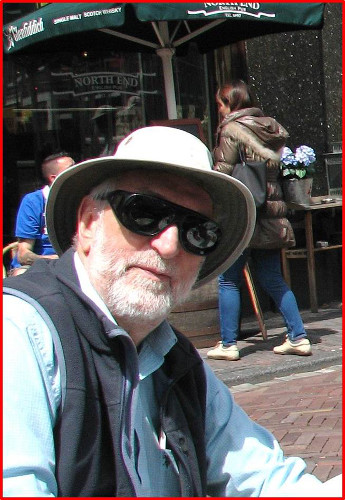 Dan Harris, 2014 (Photo courtesy of Kenneth I. Kellermann)
Dan Harris, 2014 (Photo courtesy of Kenneth I. Kellermann)
Daniel E. Harris
Contributed by Kenneth I. Kellermann
Daniel E. Harris was born in 1934 and died on December 6th 2015. In 1956, Dan became the first PhD student in the then new radio astronomy program at Caltech. One of his first research projects at Caltech, working with Jim Roberts, was measuring improved positions and flux densities for radio sources in the newly released Cambridge 3C Catalog. During this study, Dan discovered the first flat spectrum radio sources, which he named CTA 21, CTA 26, and CTA 102, and which were later identified as some of the earliest known quasars. CTA 102 later achieved fame as the first variable extra galactic radio source, leading to Russian speculation that CTA 102 was an artificial transmission from an intelligent extraterrestrial civilization.
Dan's 1961 PhD thesis on the spectra of galactic and extragalactic radio sources resulted in the then definitive study of the radio spectra and evolution of supernova remnants which established the relation between their spectral index and surface brightness. Later in his career, Dan worked on radio galaxies and active galactic nuclei (AGN), first at radio and then at X-ray wavelengths with the Einstein, ROSAT, and Chandra Observatories, where he helped to pioneer the new field of relativistic X-ray jets and how they related to radio galaxies and AGN.
Dan's broad interests in people and world politics, as well as in astrophysics, shaped his long productive astronomical career. Following his graduation from Caltech in 1961, Dan held positions in Bologna, Italy, the Arecibo Observatory in Puerto Rico, the Argentinian Institute of Radio Astronomy in Buenos Aires, the Dwingeloo Radio Observatory in the Netherlands, and at the Dominion Radio Observatory in Penticton, Canada.
In 1964, after leaving Bologna, Dan joined colleagues V. Radhakrishnan (Rad) and Dave Morris to sail from England to Puerto Rico in 36-ft trimaran. During the following years at Arecibo he worked with Marshall Cohen and others studying the newly discovered phenomena of interplanetary scintillations of compact radio sources.
Dan finally returned to the U.S. in 1980 and spent the next 35 years at the Harvard Smithsonian Astrophysical Observatory (SAO) x-ray group where he was the "in-house" radio astronomer.
As his children Justine, Seth, and Leila described, Dan "conformed to no social norm." In addition to his transatlantic adventure, Dan rafted down the Amazon with his wife, Barbara, and on his 80th birthday proudly reached the summit of Mt. Washington, NH, the highest peak in Northeastern United Sates.
![[IAU logo]](iau_wb_thumb.jpg)
![[URSI logo]](URSI-logo-thumb.jpg)
![[Karl Jansky at his antenna]](jansky_photo_02_thumb.jpg)
![[Reber's Wheaton antenna]](Reber_Telescope_Wheaton_thumb.jpg)
![[Dover Heights]](Dover_Heights_02_thumb.jpg)
![[4C telescope]](GB61-195_4C_telescope_thumb.jpg)
![[Ewen and horn antenna]](ewen_horn1s.jpg)
![[Dwingeloo, 1956]](Dwingeloo-1956-thumb.jpg)
![[Jocelyn Bell Burnell and Cambridge antenna used in pulsar discovery]](burnell2_thumb.jpg)
![[Lovell Telescope at Jodrell Bank]](site_1594_0001-500-334-20180316163019-thumb150.jpg)
![[Wilson, Penzias, and Bell Labs horn antenna]](wilson-penzias-horn_thumb.jpg)
![[6-m Millimeter Radio Telescope in Mitaka, Japan]](6m-thumb.jpg)

